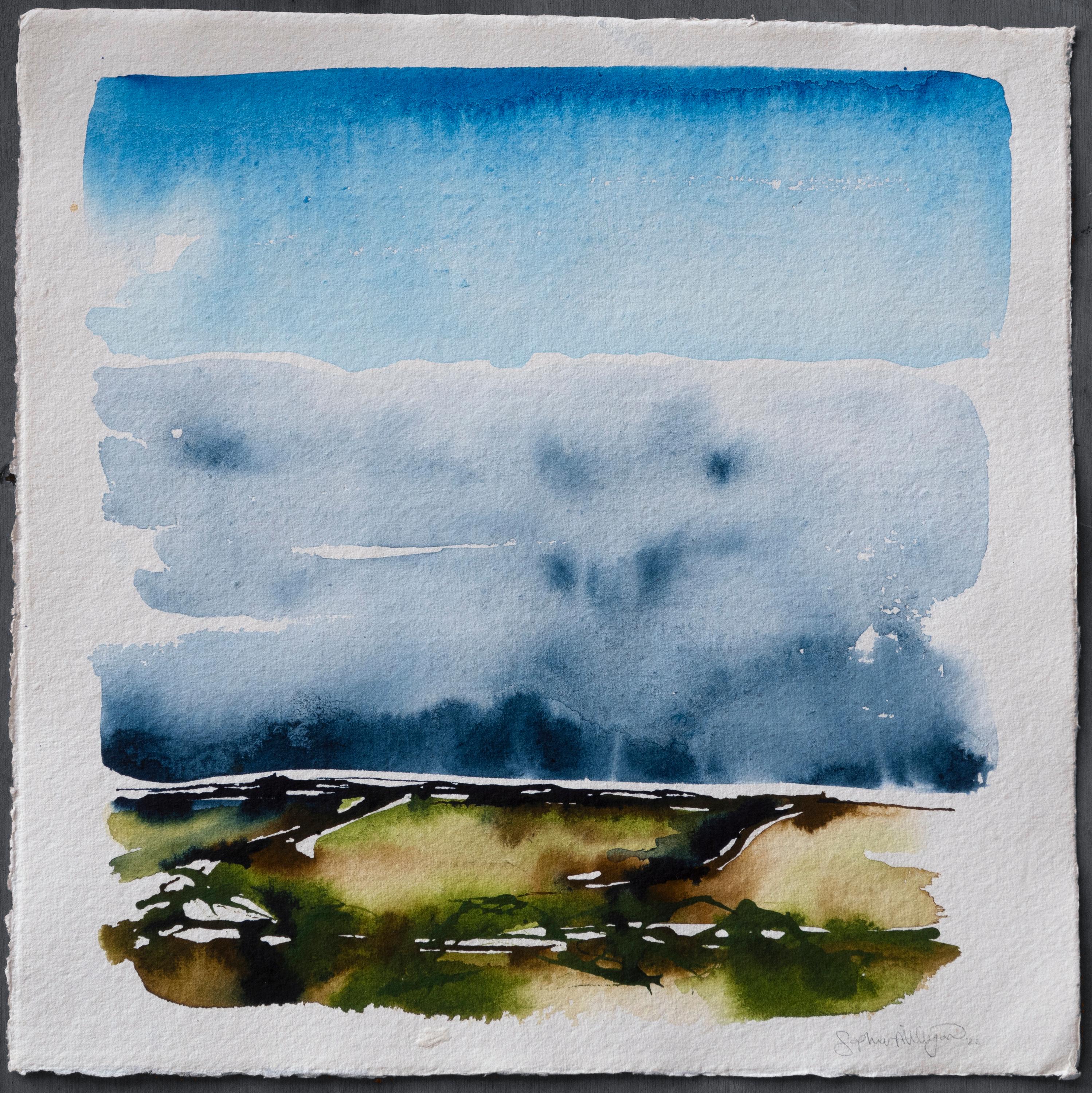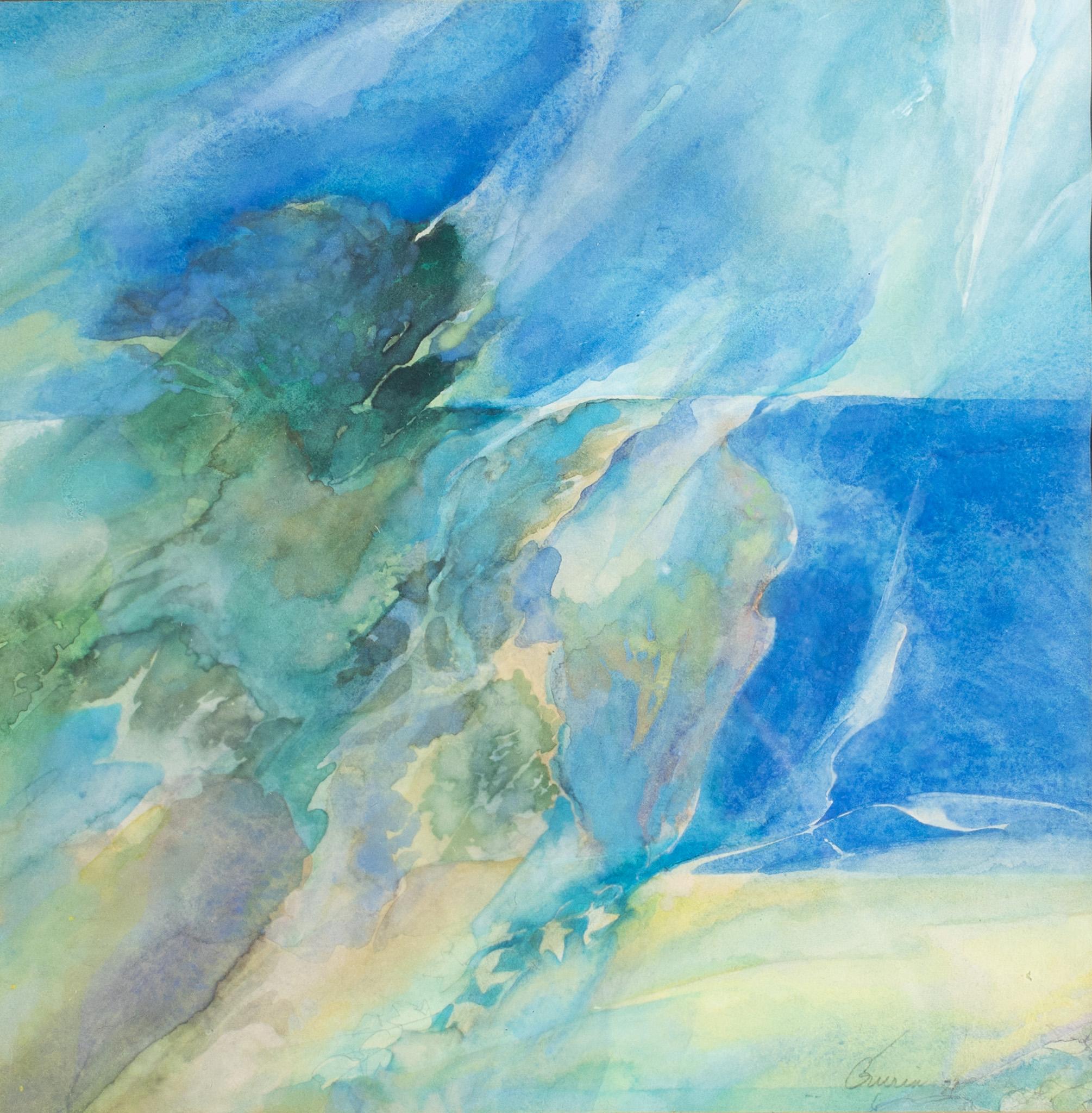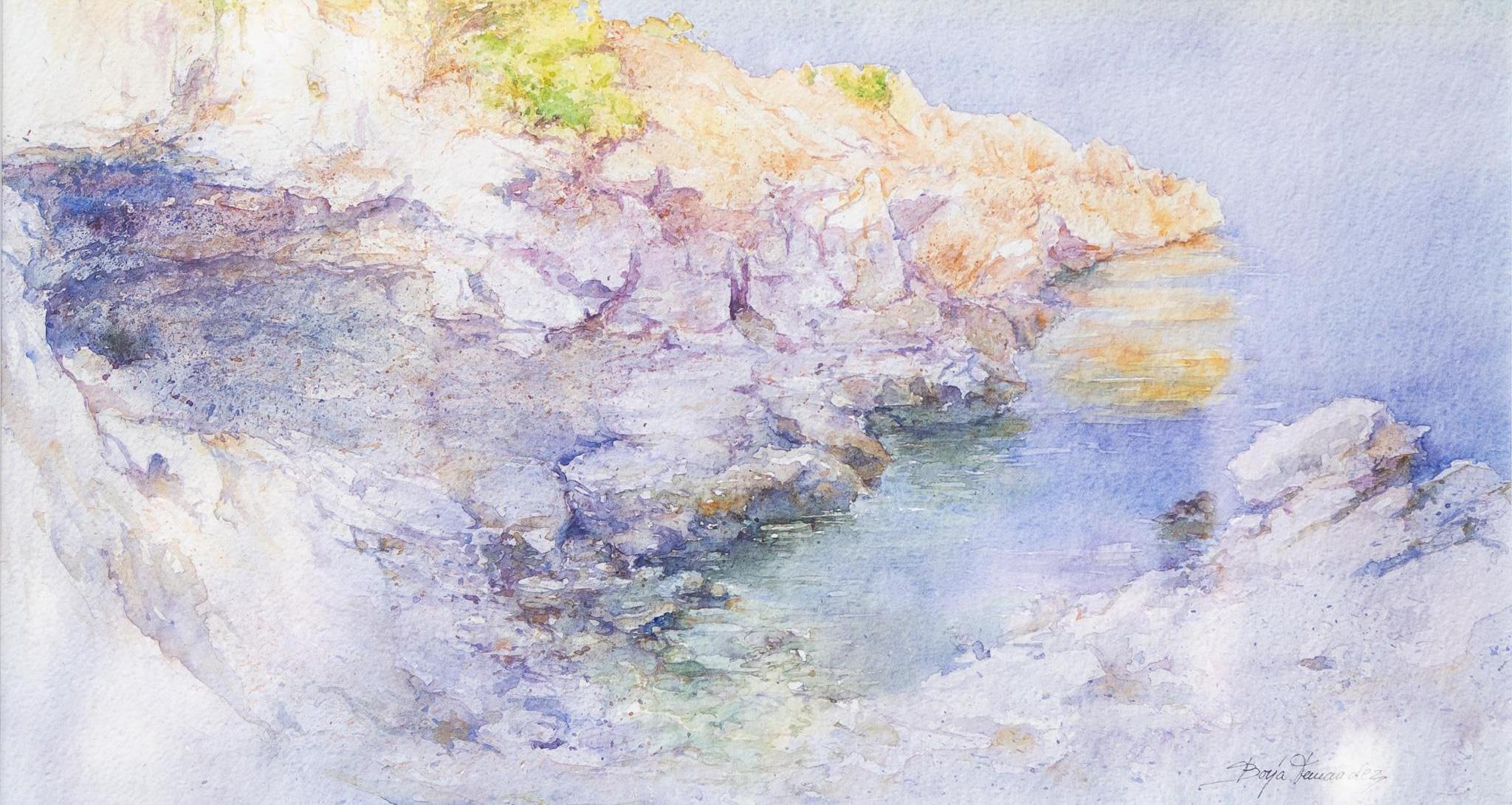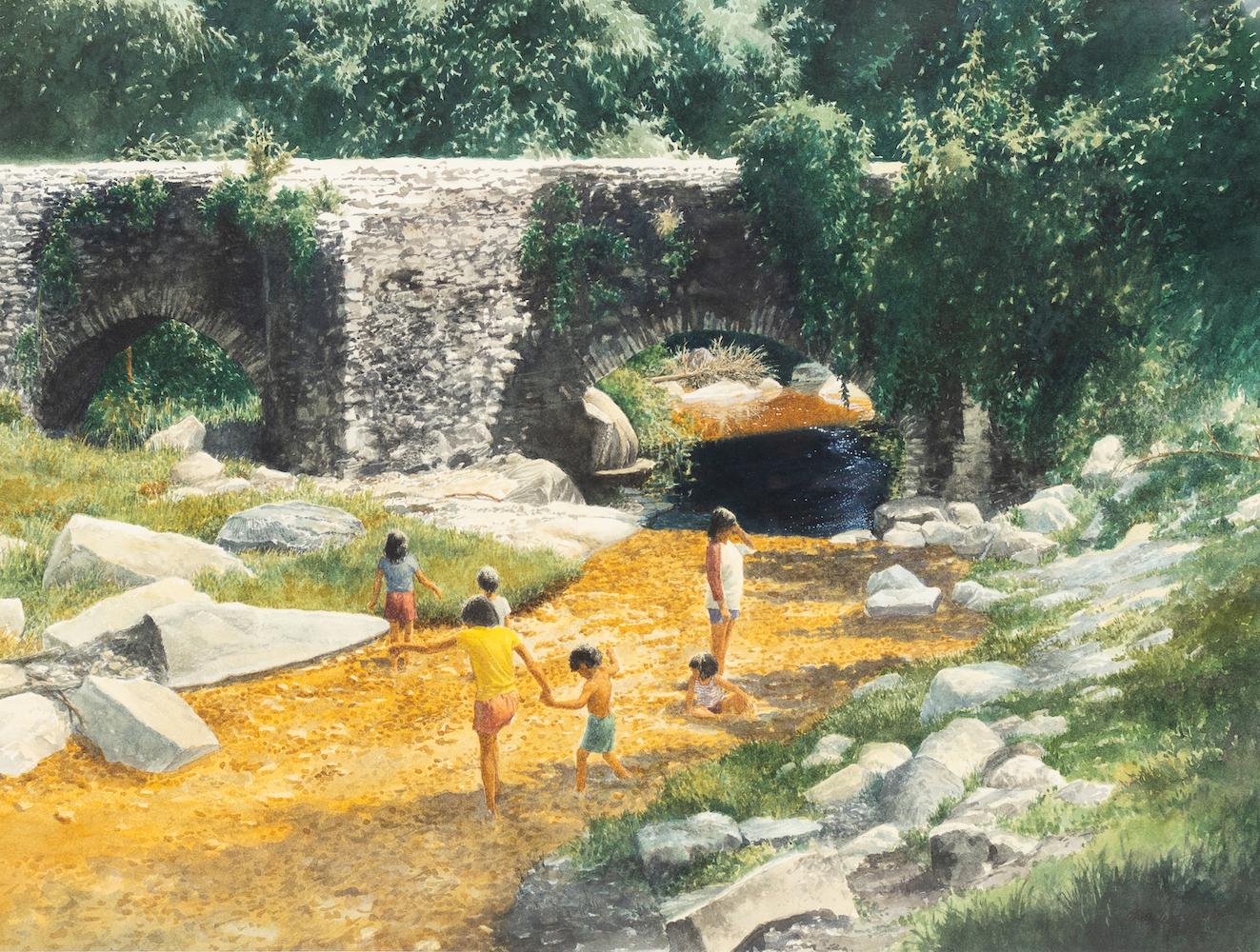Items Similar to Western Wall, Jerusalem Watercolor
Want more images or videos?
Request additional images or videos from the seller
1 of 7
Shmuel KatzWestern Wall, Jerusalem Watercolor
About the Item
Beautiful painting of the Kotel Hamaravi The Western (Wailing) Wall in Jerusalem, Israel. sight is 27X19 inches.
Shmuel Katz (Hebrew: שמואל כ"ץ) (August 18, 1926 – March 26, 2010) was an Israeli artist, illustrator, and cartoonist. A Holocaust survivor and postwar immigrant to Mandate Palestine via the detention camps on Cyprus, he figured prominently in Israeli illustration and newspaper cartooning, widely exhibiting and publishing his drawings and paintings at home and abroad, for which he won numerous local and international awards. His sketches and watercolors are known for their sprightly lines and touches of humor
Samuel Alexander (Sandor) Katz was born in Vienna, Austria, to parents of Hungarian origin. Following the Anschluss, Austria’s annexation by Nazi Germany in March 1938, the family relocated to Hungary. After the Nazi invasion of Hungary in 1944, he was deported to a forced labor camp in Yugoslavia from which he escaped to Budapest where he was among the thousands of Jews hidden in the "Glass House" shelter operated by Swiss diplomat Carl Lutz, until the arrival of the Soviet Red Army in mid-February 1945.
In Budapest, Katz joined the youth movement Hashomer Hatzair. He began studying architecture there in the Budapest University of Technology and Economics. In 1946, in the framework of the Aliyah Bet illegal immigration, he sailed aboard the Knesset Israel which was apprehended by the British and its passengers interned in a detention camp on Cyprus.
In 1947, Katz secured a legal immigration certificate as a member of the “First of May” nucleus group of Hashomer Hatzair. The group did its pioneering training at Kibbutz Eilon on the Lebanese border, and on October 8, 1948, became the founders of Kibbutz Ga'aton in the Western Galilee, where Katz spent the rest of his life. He designed the kibbutz dining room whose interior features Hungarian folkloristic wood carving.
During the years 1950–1953 Shemuel Katz illustrated Mishmar Layeladim, the weekly children’s supplement to the Mapam party’s newspaper, Al HaMishmar. In 1953–1954, he enrolled in the École nationale supérieure des Beaux-Arts in Paris, France, where he studied lithography, copperplate etching, fresco, and music, and toured the lands of Western Europe. In 1955, he joined the editorial board of Al HaMishmar as illustrator and graphics editor. In 1958, he traveled through East Africa, a journey whose impressions influenced his artistic and technical style and led to the 1962 publication of A Journey to the Land of Kush together with author Nathan Shaham. In 1976 he visited Iran, and the following November in Tehran exhibited artworks featuring Iran and Jerusalem. In 1979, Katz paid two visits to Egypt with the “Autonomy” delegation and was granted a private interview with Egyptian president Anwar Sadat. In 1983, he visited Hungary as a member of a delegation from Peace Now.
Shemuel Katz’s artworks have been exhibited extensively in Israel and abroad. His watercolors of Jerusalem have been reproduced as posters and postcards. His courtroom sketches of Adolf Eichmann’s trial in Jerusalem, 1961, are held in the art collection of Yad Vashem, Israel’s Holocaust Remembrance Authority. As an artist in the IDF, he sketched soldiers on guard and at war. Katz is well known as the illustrator of hundreds of books, especially for Sifriat Poalim, the Kibbutz Artzi movement's publishing house. Especially popular are his illustrated classics of Israeli children’s literature Shmuel Katz (Hebrew: שמואל כ"ץ) (August 18, 1926 – March 26, 2010) was an Israeli artist, illustrator, and cartoonist. A Holocaust survivor and postwar immigrant to Mandate Palestine via the detention camps on Cyprus, he figured prominently in Israeli illustration and newspaper cartooning, widely exhibiting and publishing his drawings and paintings at home and abroad, for which he won numerous local and international awards. His sketches and watercolors are known for their sprightly lines and touches of humor.
Awards and honors
1959 – Medal at the International Exhibition of Book Art, Leipzig, Germany
1961 – First prize in Drawing and Watercolor of the Biennale for Young Artists, Paris, France
1974 – Nordau Prize for Art, Tel Aviv, Israel
1985 – Nachum Gutman Memorial Award of the Tel Aviv municipality
1997 – International Award for Caricature, Budapest, Hungary
2006 – “Dosh” Memorial Award for Caricature, Einav Center, Tel Aviv
2007 – First “Golden Pencil” Award of the Israeli Museum of Caricature and Comic Art, Holon, Israel
- Creator:Shmuel Katz (1926 - 2010, Austrian, Israeli)
- Dimensions:Height: 24 in (60.96 cm)Width: 32 in (81.28 cm)
- Medium:
- Period:
- Condition:matted not framed.
- Gallery Location:Surfside, FL
- Reference Number:1stDibs: LU38210640812
About the Seller
4.9
Platinum Seller
These expertly vetted sellers are 1stDibs' most experienced sellers and are rated highest by our customers.
Established in 1995
1stDibs seller since 2014
1,550 sales on 1stDibs
Typical response time: 1 hour
- ShippingRetrieving quote...Ships From: Surfside, FL
- Return PolicyA return for this item may be initiated within 3 days of delivery.
More From This SellerView All
- Gouache Watercolor Painting, Nantucket Harbor Boats American Deaf Modernist ArtBy Robert FreimanLocated in Surfside, FLAbstract harbor scene with boats, in bold, vivid colors on heavy mould made paper. Hand signed and dated, 1980 22 X 30 not frame Robert Freiman, deaf from birth, was born in March 1917 in New York City. He attended an oral program near his home and later transferred to the Lexington School for the Deaf when he was six. Early in his childhood, his love for drawing, painting and studying became apparent, and as an adult, he continued his studies in New York at the National Academy of Design, Pratt Institute, the Art Students League and the Parsons School of Design. In Paris, France he studied at the Ecole des Beaux Arts. Bob Freiman was especially focused on painting portraits and figures in motion in various mediums, especially the mixed-media combination of watercolor, acrylic and pen. Among his subjects were acrobats, ballet dancers, cyclists and other athletes. He as well focused on abstracts for a time, discovering new media in his works with quick brushwork and expressive movements. In the latter part of his career, his style became abstract and surreal with images of metaphysical landscapes with architectural elements such as arches, towers, pyramids and castles floating in the air. The famed art critic Pierre Rouve wrote: “It is therefore refreshing to see them revitalized by the colourist wealth and virile handwriting of Robert Freiman, probably the best American water-colorist since John Marin. He worked in Provincetown and Nantucket and regularly exhibited there. He showed at Doll & Richards gallery of Boston alongside John Chetcuti, Lloyd Goodrich, Tod Lindenmuth, William Meyerowitz, Dwight Shepler, Elizabeth O'Neill Verner, Stanley Woodward, Andrew Wyeth, and others. His work bears the influence of the mid century school of Paris in particular Jean Carzou. He was a regular exhibitor at the Sidewalk Art...Category
1980s Expressionist Figurative Paintings
MaterialsWatercolor, Gouache, Archival Paper
- Modernist Abstract Expressionist Watercolor Painting Bauhaus Weimar Pawel KontnyBy Pawel KontnyLocated in Surfside, FLAbstract watercolor composition bearing the influence of the earlier color-block compositions of Paul Klee. Pawel August Kontny, (Polish-German-American artist) He was born in Laurahuette, Poland, in 1923, the son of a wealthy pastry shop owner. In 1939 he began studying architecture in Breslau where he was introduced to the European masters and to the work of some of the German Expressionists, soon afterward banned as "degenerate artists" and removed from museums throughout Germany by the Nazi regime. His studies were interrupted by World War II. Drafted into the German army, traveling in many countries as a soldier, he sketched various landscapes but in 1945, he was captured and held as a prisoner of war in Italy. After the war, he studied at the Union of Nuremberg Architects to help design buildings to replace ones destroyed in the war. He recorded his impressions of the local population and the landscapes through his watercolors and drawings. Pawel Kontny thereafter moved to Nuremberg, Germany, becoming a member of the Union of Nuremberg Architects and helping to rebuild the city's historic center. He soon decided to concentrate on his professional art career. He married Irmgard Laurer, a dancer with the Nuremberg Opera. Pavel Kontny 's career as an artist was launched with his participation in an all German exhibition, held at the Dusseldorf Museum in 1952. He held one-man shows in Germany, Switzerland and the United States. During his trip to the United States in 1960, Kontny became instantly enamored with Colorado, and decided to relocate to Cherry Hills with his wife and two children. He quickly established himself in the local art community, being affiliated for a time with Denver Art Galleries and Saks Galleries. His subject matter became the Southwest. During this time he received the Prestigious Gold Medal of the Art Academy of Rome. His extensive travel provided material for the paintings he did using his hallmark marble dust technique. he also worked equally in pastel, watercolor, charcoal and pencil-and-ink. in a style which merged abstraction and realist styles, influenced by Abstract Expressionist painting and South Western American landscapes. This one bears the influence of Sam Francis. In the early 1960s he was one of only a few European-born professional artists in the state, a select group that included Herbert Bayer (1900-1985), a member of the prewar Bauhaus in Weimar and Dessau, Germany, and Roland Detre (1903-2001), a Hungarian modernist painter. As a Denver, Colorado resident, Pavel Kontny exhibited at galleries and museums throughout the United States, Germany and Japan. There, he was inspired by frequent trips to Native American pueblos in the Southwest, as well as by the study of the Plains Indians of Montana and Wyoming. Over the years Kontny had a number of students and generously helped young artist by hosting exhibitions at his Cherry Hills home. For many years he generously donated his paintings to support charitable causes in Denver. Influences during his European years included German pastelist C.O. Muller, German Informel painter Karl Dahmen and Swiss artist, Hans Erni. In the early 1950s his painting style showed the influence of the Die Brücke (The Bridge), a group of German expressionist artists formed in Dresden in 1905 who had a major impact on the evolution of modern art in the twentieth century in Germany. By the middle of the decade his style incorporated more referential abstraction and total abstraction, resulting in part from his study of Hans Hartung, a German artist based in Paris who exhibited his gestural abstract work in Germany. The American moon landing in 1969 inspired Paul Kontny...Category
20th Century American Modern Abstract Drawings and Watercolors
MaterialsWatercolor, Archival Paper
- Modernist Abstract Expressionist Watercolor Painting Bauhaus Weimar Pawel KontnyBy Pawel KontnyLocated in Surfside, FLAbstract watercolor composition bearing the influence of the earlier color-block compositions of Paul Klee. Pawel August Kontny, (Polish-German-American artist) He was born in Laurahuette, Poland, in 1923, the son of a wealthy pastry shop owner. In 1939 he began studying architecture in Breslau where he was introduced to the European masters and to the work of some of the German Expressionists, soon afterward banned as "degenerate artists" and removed from museums throughout Germany by the Nazi regime. His studies were interrupted by World War II. Drafted into the German army, traveling in many countries as a soldier, he sketched various landscapes but in 1945, he was captured and held as a prisoner of war in Italy. After the war, he studied at the Union of Nuremberg Architects to help design buildings to replace ones destroyed in the war. He recorded his impressions of the local population and the landscapes through his watercolors and drawings. Pawel Kontny thereafter moved to Nuremberg, Germany, becoming a member of the Union of Nuremberg Architects and helping to rebuild the city's historic center. He soon decided to concentrate on his professional art career. He married Irmgard Laurer, a dancer with the Nuremberg Opera. Pavel Kontny 's career as an artist was launched with his participation in an all German exhibition, held at the Dusseldorf Museum in 1952. He held one-man shows in Germany, Switzerland and the United States. During his trip to the United States in 1960, Kontny became instantly enamored with Colorado, and decided to relocate to Cherry Hills with his wife and two children. He quickly established himself in the local art community, being affiliated for a time with Denver Art Galleries and Saks Galleries. His subject matter became the Southwest. During this time he received the Prestigious Gold Medal of the Art Academy of Rome. His extensive travel provided material for the paintings he did using his hallmark marble dust technique. he also worked equally in pastel, watercolor, charcoal and pencil-and-ink. in a style which merged abstraction and realist styles, influenced by Abstract Expressionist painting and South Western American landscapes. This one bears the influence of Sam Francis. In the early 1960s he was one of only a few European-born professional artists in the state, a select group that included Herbert Bayer (1900-1985), a member of the prewar Bauhaus in Weimar and Dessau, Germany, and Roland Detre (1903-2001), a Hungarian modernist painter. As a Denver, Colorado resident, Pavel Kontny exhibited at galleries and museums throughout the United States, Germany and Japan. There, he was inspired by frequent trips to Native American pueblos in the Southwest, as well as by the study of the Plains Indians of Montana and Wyoming. Over the years Kontny had a number of students and generously helped young artist by hosting exhibitions at his Cherry Hills home. For many years he generously donated his paintings to support charitable causes in Denver. Influences during his European years included German pastelist C.O. Muller, German Informel painter Karl Dahmen and Swiss artist, Hans Erni. In the early 1950s his painting style showed the influence of the Die Brücke (The Bridge), a group of German expressionist artists formed in Dresden in 1905 who had a major impact on the evolution of modern art in the twentieth century in Germany. By the middle of the decade his style incorporated more referential abstraction and total abstraction, resulting in part from his study of Hans Hartung, a German artist based in Paris who exhibited his gestural abstract work in Germany. The American moon landing in 1969 inspired Paul Kontny...Category
20th Century American Modern Abstract Drawings and Watercolors
MaterialsWatercolor, Archival Paper
- Modernist Abstract Expressionist Watercolor Painting Bauhaus Weimar Pawel KontnyBy Pawel KontnyLocated in Surfside, FLAbstract watercolor composition bearing the influence of the earlier color-block compositions of Paul Klee. Pawel August Kontny, (Polish-German-American artist) He was born in Laurahuette, Poland, in 1923, the son of a wealthy pastry shop owner. In 1939 he began studying architecture in Breslau where he was introduced to the European masters and to the work of some of the German Expressionists, soon afterward banned as "degenerate artists" and removed from museums throughout Germany by the Nazi regime. His studies were interrupted by World War II. Drafted into the German army, traveling in many countries as a soldier, he sketched various landscapes but in 1945, he was captured and held as a prisoner of war in Italy. After the war, he studied at the Union of Nuremberg Architects to help design buildings to replace ones destroyed in the war. He recorded his impressions of the local population and the landscapes through his watercolors and drawings. Pawel Kontny thereafter moved to Nuremberg, Germany, becoming a member of the Union of Nuremberg Architects and helping to rebuild the city's historic center. He soon decided to concentrate on his professional art career. He married Irmgard Laurer, a dancer with the Nuremberg Opera. Pavel Kontny 's career as an artist was launched with his participation in an all German exhibition, held at the Dusseldorf Museum in 1952. He held one-man shows in Germany, Switzerland and the United States. During his trip to the United States in 1960, Kontny became instantly enamored with Colorado, and decided to relocate to Cherry Hills with his wife and two children. He quickly established himself in the local art community, being affiliated for a time with Denver Art Galleries and Saks Galleries. His subject matter became the Southwest. During this time he received the Prestigious Gold Medal of the Art Academy of Rome. His extensive travel provided material for the paintings he did using his hallmark marble dust technique. he also worked equally in pastel, watercolor, charcoal and pencil-and-ink. in a style which merged abstraction and realist styles, influenced by Abstract Expressionist painting and South Western American landscapes. This one bears the influence of Sam Francis. In the early 1960s he was one of only a few European-born professional artists in the state, a select group that included Herbert Bayer (1900-1985), a member of the prewar Bauhaus in Weimar and Dessau, Germany, and Roland Detre (1903-2001), a Hungarian modernist painter. As a Denver, Colorado resident, Pavel Kontny exhibited at galleries and museums throughout the United States, Germany and Japan. There, he was inspired by frequent trips to Native American pueblos in the Southwest, as well as by the study of the Plains Indians of Montana and Wyoming. Over the years Kontny had a number of students and generously helped young artist by hosting exhibitions at his Cherry Hills home. For many years he generously donated his paintings to support charitable causes in Denver. Influences during his European years included German pastelist C.O. Muller, German Informel painter Karl Dahmen and Swiss artist, Hans Erni. In the early 1950s his painting style showed the influence of the Die Brücke (The Bridge), a group of German expressionist artists formed in Dresden in 1905 who had a major impact on the evolution of modern art in the twentieth century in Germany. By the middle of the decade his style incorporated more referential abstraction and total abstraction, resulting in part from his study of Hans Hartung, a German artist based in Paris who exhibited his gestural abstract work in Germany. The American moon landing in 1969 inspired Paul Kontny...Category
20th Century American Modern Abstract Drawings and Watercolors
MaterialsWatercolor, Archival Paper
- Israeli Modernist Watercolor Painting Jerusalem Landscape Bezalel School AvnielBy Mordechai AvnielLocated in Surfside, FLWatercolor painting of Old City of Jerusalem MORDECHAI AVNIEL Minsk, Belarus, b. 1900, d. 1989 Mordecai Dickstein (later Avniel) was born in 1900 in Minsk, present-day Belarus. He studied fine arts in Yekaterinburg, Russia (1913–19) and at the Bezalel Academy of Art and Design, Jerusalem (1923). Avniel immigrated to Palestine in 1921 where he first worked as a pioneer in citrus plantations near Petah Tikva. In 1923, at the urging of Boris Schatz, he went to Jerusalem to further his art studies at Bezalel. He later taught painting and sculpture at the school, and served a term as director of the Small Sculpture Section of the Sculpture Department (1924–28). From 1935 on, Avniel lived in Haifa. Avniel was also a lawyer and a founding partner of the Haifa firm Avniel, Salomon & Company. Avniel regularly showed his work in group exhibitions of the Painters and Sculptors' Association of Israel. He was awarded the Herman Struck Prize (1952), Tenth Anniversary Prize for Watercolours, Ramat Gan (1958), Histadrut Prize (1961), and First Prize Haifa Municipality (1977). He represented Israel at the 1958 Venice Biennale and the 1962 International Art Seminar at Fairleigh Dickinson University. Avniel was a member of the Artists' Colony in Safed and maintained a studio on Mount Carmel. Mordechai Avniel is best known for his deft and singular landscape work. His works are held in numerous museums and collections both in Israel and abroad, including the Metropolitan Museum, New York and the Carnegie Institute, Pittsburgh, PA. Avniel's manipulations of light and colour share much with those of compatriot artists Shimshon Holzman and Joseph Kossonogi. Education 1913-19 Art School of Katrinburg, Russia 1923 Bezalel School of Art, Jerusalem Selected exhibitions: 2004: Our Landscape: Notes on Landscape Painting in Israel, University of Haifa Art Gallery, Haifa (online catalogue) 1965: Mordechai Avniel Retrospective, Haifa Municipality Museum of Modern Art, Haifa 1964: Galerie Synthèse, Paris 1962: New York University, New York 1961: Rina Gallery of Modern Art, Jerusalem The Autumn Exhibition Rina Gallery, Jerusalem Artists: Dedi Ben Shaul, Lea Nikel, Yossef Zaritsky,Ephraim Fima Roytenberg, Zvi Meirovich, Aharon Kahana, Avigdor Stematsky, Mordechai Levanon, Yosl Bergner, Israel Paldi...Category
20th Century Modern Interior Drawings and Watercolors
MaterialsPaper, Watercolor
- Israeli Modernist Safed Synagogue Interior Folk Art Watercolor PaintingBy Zvi EhrmanLocated in Surfside, FLIn this piece the artist choice of colors is vibrant, and there is minimal blending of them. The artist takes a naive, Folk Art approach at rendering the subject simplifying the figu...Category
Mid-20th Century Modern Landscape Drawings and Watercolors
MaterialsPaper, Watercolor
You May Also Like
- 'Fall Fog Approaching'. Contemporary Landscape Clouds Moody sky Blue Green BrownBy Sophia MilliganLocated in Penzance, GB'Fall Fog, Approaching'. Contemporary landscape painting, Cornwall Original Artwork, Unframed _________________ Heavy skies moving in over the autumnal landscape of West Cornwall: a ...Category
2010s Contemporary Landscape Drawings and Watercolors
MaterialsInk, Watercolor, Archival Paper
- Vu d'ici - Watercolour, Painting on paper, Landscape, SeasideLocated in AIX-EN-PROVENCE, FRWatercolour, Acrylic Painting on archival paper. Work Title : "Vu d'ici" (EN : Seen from here) Artist : Fabien Granet (FR) The work is signed and dated on the back of the work. Uniq...Category
21st Century and Contemporary Contemporary Landscape Paintings
MaterialsWatercolor, Acrylic, Archival Paper
- Arborescencias IVBy Ignacio de LuccaLocated in Miami, FLWatercolor on PaperCategory
2010s Contemporary Landscape Drawings and Watercolors
MaterialsWatercolor, Archival Paper
- "Abstract Landscape" Watercolor PaintingBy John GuerinLocated in Austin, TXAbstract landscape resembling a blue, green, yellow, and white. This piece is painted with watercolor and measuring 13" x 13". The frame measures 22" x 24".Category
1970s Abstract Abstract Drawings and Watercolors
MaterialsWatercolor, Archival Paper
- Costal Watercolor SeascapeBy Borja FernandezLocated in Austin, TXBy Borja Fernandez This coastal European seascape features rocky tan cliffs with purple and blue water below. This scene depicts the coast of Mallorca, Spain.Category
21st Century and Contemporary Landscape Drawings and Watercolors
MaterialsArchival Paper, Watercolor
- "Children in a Creek" Playful Sunny Landscape Water Bridge Forest Rocks HappyLocated in Austin, TXThis idyllic scene shows children playing in a creek next to a cobblestone bridge on a sunny day. The surrounding foliage is lush and green. By Charles Shaw 17.5" x 23" Watercolor on...Category
20th Century American Realist Landscape Drawings and Watercolors
MaterialsWatercolor, Archival Paper
Recently Viewed
View AllMore Ways To Browse
Western Drawings
Jerusalem Art
Western Art Drawings
Western Artwork
The Western Wall Art
20th Century Western Paintings
Vintage Western Paper
Israel Jerusalem
Jerusalem Paintings
Western Watercolors
Paintings Of Jerusalem
Western Book
Art Western Watercolor
Western Glass
Western Glasses
Hungary Poster
Katz Artist
Vintage Comic Art





